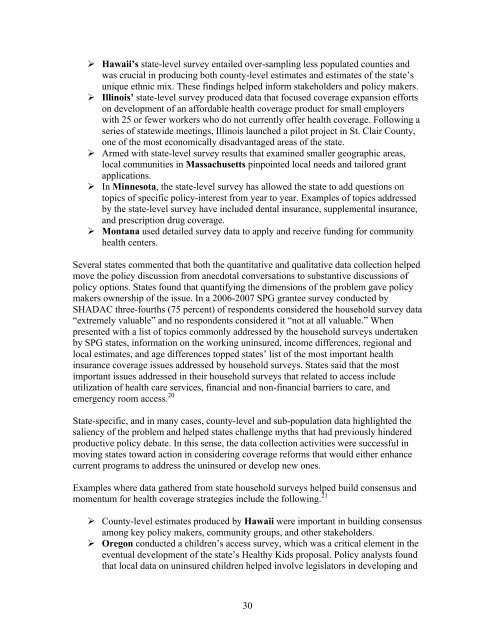SPG synthesis report - State Coverage Initiatives
SPG synthesis report - State Coverage Initiatives
SPG synthesis report - State Coverage Initiatives
You also want an ePaper? Increase the reach of your titles
YUMPU automatically turns print PDFs into web optimized ePapers that Google loves.
� Hawaii’s state-level survey entailed over-sampling less populated counties and<br />
was crucial in producing both county-level estimates and estimates of the state’s<br />
unique ethnic mix. These findings helped inform stakeholders and policy makers.<br />
� Illinois’ state-level survey produced data that focused coverage expansion efforts<br />
on development of an affordable health coverage product for small employers<br />
with 25 or fewer workers who do not currently offer health coverage. Following a<br />
series of statewide meetings, Illinois launched a pilot project in St. Clair County,<br />
one of the most economically disadvantaged areas of the state.<br />
� Armed with state-level survey results that examined smaller geographic areas,<br />
local communities in Massachusetts pinpointed local needs and tailored grant<br />
applications.<br />
� In Minnesota, the state-level survey has allowed the state to add questions on<br />
topics of specific policy-interest from year to year. Examples of topics addressed<br />
by the state-level survey have included dental insurance, supplemental insurance,<br />
and prescription drug coverage.<br />
� Montana used detailed survey data to apply and receive funding for community<br />
health centers.<br />
Several states commented that both the quantitative and qualitative data collection helped<br />
move the policy discussion from anecdotal conversations to substantive discussions of<br />
policy options. <strong>State</strong>s found that quantifying the dimensions of the problem gave policy<br />
makers ownership of the issue. In a 2006-2007 <strong>SPG</strong> grantee survey conducted by<br />
SHADAC three-fourths (75 percent) of respondents considered the household survey data<br />
“extremely valuable” and no respondents considered it “not at all valuable.” When<br />
presented with a list of topics commonly addressed by the household surveys undertaken<br />
by <strong>SPG</strong> states, information on the working uninsured, income differences, regional and<br />
local estimates, and age differences topped states’ list of the most important health<br />
insurance coverage issues addressed by household surveys. <strong>State</strong>s said that the most<br />
important issues addressed in their household surveys that related to access include<br />
utilization of health care services, financial and non-financial barriers to care, and<br />
emergency room access. 20<br />
<strong>State</strong>-specific, and in many cases, county-level and sub-population data highlighted the<br />
saliency of the problem and helped states challenge myths that had previously hindered<br />
productive policy debate. In this sense, the data collection activities were successful in<br />
moving states toward action in considering coverage reforms that would either enhance<br />
current programs to address the uninsured or develop new ones.<br />
Examples where data gathered from state household surveys helped build consensus and<br />
momentum for health coverage strategies include the following. 21<br />
� County-level estimates produced by Hawaii were important in building consensus<br />
among key policy makers, community groups, and other stakeholders.<br />
� Oregon conducted a children’s access survey, which was a critical element in the<br />
eventual development of the state’s Healthy Kids proposal. Policy analysts found<br />
that local data on uninsured children helped involve legislators in developing and<br />
30






